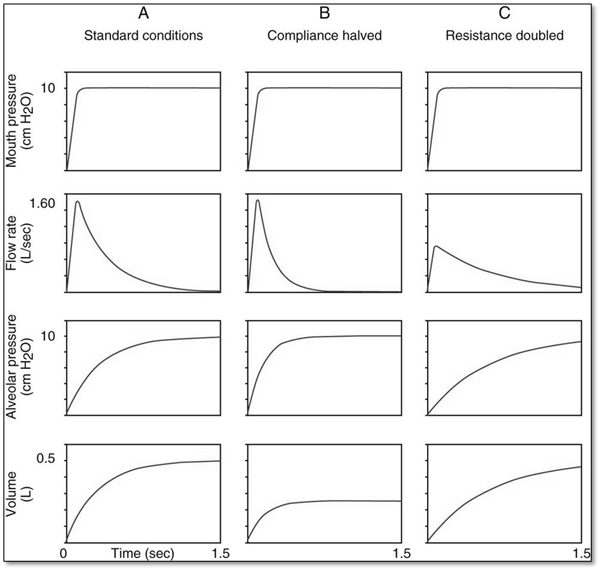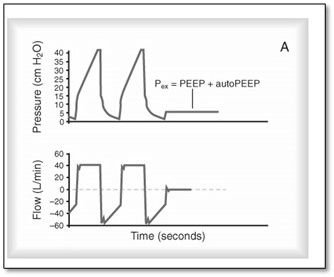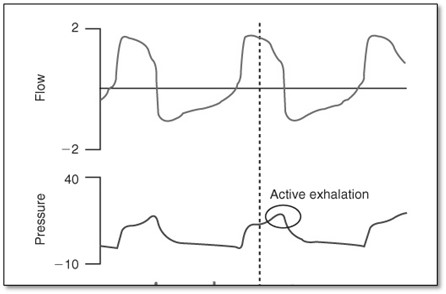5.1 Waveforms
Understanding and interpreting ventilator graphics (e.g., waveforms) are important skills for clinicians to have when working with patients requiring mechanical ventilation. After initiating mechanical ventilation, waveforms should be analyzed to ensure that the patient’s demand is met and whether or not they are synchronous with the ventilation.[1]
View the following supplementary YouTube video[2] to gain a better understanding of ventilator graphics: Mechanical Ventilation Basics – Waveforms/Scalars (Press, Flow, Volume) + Loops | Clinical Medicine
In Figure 5[3] below, A demonstrates curves under normal conditions, and B demonstrates a situation where static lung compliance is reduced. In these circumstances, the lung accepts less volume and, therefore, requires less time to fill and C demonstrates a situation where resistance is increased. In these circumstances the flow that can flow through the airways decreases and, therefore, more time is required to administer normal tidal volume (Vt).

It is important to assess the presence of auto-PEEP in ventilated patients. Auto-PEEP increases the patient’s mean airway pressure and may contribute to complications associated with mechanical ventilation, especially barotrauma, volutrauma, and hypotension. By activating the expiratory pause as shown in diagram A, the expiratory valve closes during static expiration. In the presence of auto-PEEP the airway flow continues to flow into the tubing. An equilibrium occurs between the lung and the ventilator and the measured pressure estimates the patient’s auto-PEEP. (See Figure 6.[4])

If the I-time is too long for the patient and they want to exhale before the expiratory valve opens you will see asynchrony. (See Figure 7.[5])

When two breaths are observed very close together, this may be an indication that the exhalation occurred too early. Therefore, the patient triggers a second breath immediately afterwards, producing almost “breath stacking.” During ventilation, the ventilator-set I-time concludes, but the patient’s inspiratory muscles are still contracting, resulting in a drop in pressure. Should this drop in pressure reach the trigger sensitivity level, it will prompt the ventilator to deliver another breath, causing the appearance of double triggering.
View the following supplementary YouTube video[6] that shows double triggering: Patient Ventilator Asynchrony: Double trigger
- Harrigan, D. & Verville-Fiset, J. (2023). Reference manual: Respiratory therapy. Open Library. https://ecampusontario.pressbooks.pub/therapielacite/chapter/chapitre-3-la-ventilation-mecanique/ ↵
- Whiteboard Medicine. (2022, December 21). Mechanical ventilation basics - waveforms/scalars (Press, Flow, Volume) + loops | clinical medicine [Video}. YouTube. All rights reserved. https://www.youtube.com/watch?v=8pKZ3XYCOio&t=4s ↵
- “Picture8-2.png” by unknown author is licensed under CC BY-NC-SA 4.0. Access for free at https://ecampusontario.pressbooks.pub/therapielacite/chapter/chapitre-3-la-ventilation-mecanique/ ↵
- “Picture10-2.jpg” by unknown author is licensed under CC BY-NC-SA 4.0. Access for free at https://ecampusontario.pressbooks.pub/therapielacite/chapter/chapitre-3-la-ventilation-mecanique/ ↵
- “Picture12-1.jpg” by unknown author is licensed under CC BY-NC-SA 4.0. Access for free at https://ecampusontario.pressbooks.pub/therapielacite/chapter/chapitre-3-la-ventilation-mecanique/ ↵
- FREMITUS. (2011, March 4). Patient ventilator asynchrony: double trigger [Video]. YouTube. All rights reserved. https://www.youtube.com/watch?v=G6kUx1sRKcI ↵

